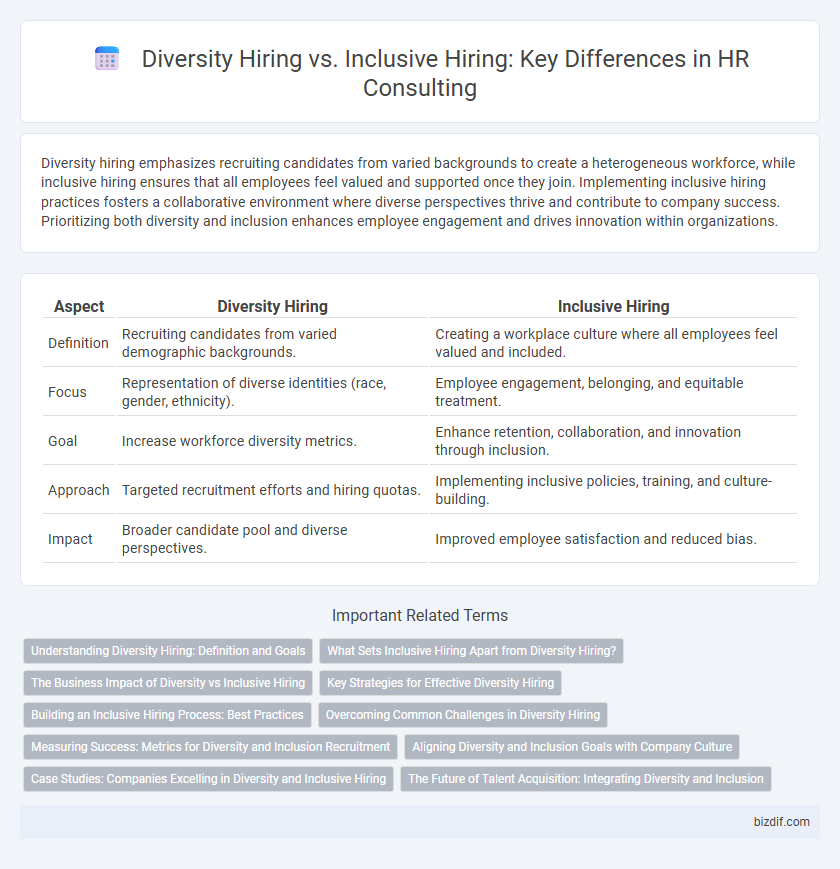Diversity hiring emphasizes recruiting candidates from varied backgrounds to create a heterogeneous workforce, while inclusive hiring ensures that all employees feel valued and supported once they join. Implementing inclusive hiring practices fosters a collaborative environment where diverse perspectives thrive and contribute to company success. Prioritizing both diversity and inclusion enhances employee engagement and drives innovation within organizations.
Table of Comparison
| Aspect | Diversity Hiring | Inclusive Hiring |
|---|---|---|
| Definition | Recruiting candidates from varied demographic backgrounds. | Creating a workplace culture where all employees feel valued and included. |
| Focus | Representation of diverse identities (race, gender, ethnicity). | Employee engagement, belonging, and equitable treatment. |
| Goal | Increase workforce diversity metrics. | Enhance retention, collaboration, and innovation through inclusion. |
| Approach | Targeted recruitment efforts and hiring quotas. | Implementing inclusive policies, training, and culture-building. |
| Impact | Broader candidate pool and diverse perspectives. | Improved employee satisfaction and reduced bias. |
Understanding Diversity Hiring: Definition and Goals
Diversity hiring involves recruiting candidates from varied demographic backgrounds to create a workforce that reflects different races, genders, ages, and cultures. The primary goal is to increase representation and reduce biases in candidate selection processes. This strategy enhances organizational innovation and decision-making by incorporating multiple perspectives.
What Sets Inclusive Hiring Apart from Diversity Hiring?
Inclusive hiring goes beyond merely increasing workforce diversity by fostering an environment where all employees feel valued, respected, and empowered to contribute. While diversity hiring focuses on representation metrics such as race, gender, and ethnicity, inclusive hiring emphasizes equitable practices in recruitment, onboarding, and career development to ensure true belonging and retention. Companies that prioritize inclusive hiring report higher employee engagement, reduced turnover, and improved innovation through diverse perspectives being actively integrated into decision-making processes.
The Business Impact of Diversity vs Inclusive Hiring
Diversity hiring boosts innovation and decision-making by bringing varied perspectives to the workplace, which enhances company performance and market competitiveness. Inclusive hiring fosters a sense of belonging, increasing employee engagement, retention, and productivity. Combining diversity with inclusion strategies yields measurable business outcomes such as higher profitability, improved talent attraction, and stronger corporate reputation.
Key Strategies for Effective Diversity Hiring
Key strategies for effective diversity hiring include leveraging blind recruitment techniques to minimize unconscious bias and implementing structured interviews to ensure consistency in candidate evaluation. Utilizing diverse talent pools and partnering with organizations that support underrepresented groups enhances workforce representation. Continuous training on inclusive hiring practices and setting measurable diversity goals enable organizations to track progress and foster equitable workplace environments.
Building an Inclusive Hiring Process: Best Practices
Building an inclusive hiring process involves creating structured interview frameworks that reduce bias and emphasize candidates' diverse experiences and skills. Utilizing tools like blind resume reviews and diverse hiring panels enhances fairness and representation throughout recruitment. Continuous training for HR teams on cultural competence and inclusive language further supports equitable candidate evaluation and fosters a more inclusive workplace culture.
Overcoming Common Challenges in Diversity Hiring
Overcoming common challenges in diversity hiring requires tailored strategies that target unconscious bias and limited talent pipelines, ensuring recruitment processes attract candidates from varied backgrounds. Leveraging data-driven insights and structured interviews enhances equitable candidate evaluation, reducing subjective decision-making. Integrating inclusive hiring practices encourages employee engagement and retention by fostering a workplace culture where diverse perspectives are valued and empowered.
Measuring Success: Metrics for Diversity and Inclusion Recruitment
Measuring success in diversity hiring involves tracking metrics such as demographic representation, hiring rates across various underrepresented groups, and retention statistics to evaluate workforce composition changes. Inclusive hiring metrics focus on employee engagement scores, inclusion survey results, and promotion rates among diverse employees to assess workplace belonging and equitable opportunities. Combining quantitative diversity data with qualitative inclusion feedback provides a comprehensive view of recruitment effectiveness in HR consulting strategies.
Aligning Diversity and Inclusion Goals with Company Culture
Aligning diversity hiring goals with company culture requires a strategic focus on not only attracting candidates from varied backgrounds but also fostering an inclusive environment where diverse talents can thrive. Inclusive hiring emphasizes equitable practices and creating a workplace culture that values collaboration, belonging, and respect, ensuring that diversity efforts translate into meaningful employee engagement and retention. Companies that integrate diversity and inclusion goals effectively into their organizational values experience higher innovation, improved team dynamics, and a stronger employer brand.
Case Studies: Companies Excelling in Diversity and Inclusive Hiring
Case studies reveal that companies adopting inclusive hiring practices, such as Salesforce and Accenture, experience higher employee retention and innovation rates compared to those focusing solely on diversity metrics. Salesforce's use of inclusive recruitment strategies ensures diverse talent integration and equitable career development, leading to a 17% increase in employee engagement. Accenture's emphasis on inclusive hiring combined with continuous bias training reduced turnover by 15%, demonstrating the tangible benefits of fostering inclusive workplace cultures alongside diversity hiring.
The Future of Talent Acquisition: Integrating Diversity and Inclusion
Diversity hiring focuses on recruiting candidates from varied backgrounds to create a multifaceted workforce, while inclusive hiring ensures these diverse employees feel valued and integrated within the company culture. The future of talent acquisition emphasizes seamless integration of diversity and inclusion strategies, leveraging data analytics and bias reduction tools to enhance recruitment outcomes. Organizations investing in comprehensive D&I initiatives report higher employee engagement, innovation, and retention rates, positioning them for competitive advantage.
diversity hiring vs inclusive hiring Infographic

 bizdif.com
bizdif.com